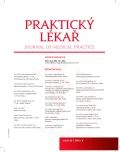Mother’s obesity and excessive screen time increase the odds for overweight/obesity among pre-schoolers
Authors:
E. Sigmund; P. Baďura; J. Vokáčová; D. Sigmundová
Authors‘ workplace:
Vedoucí: prof. PhDr. Karel Frömel, DrSc.
; Fakulta tělesné kultury
; Institut aktivního životního stylu
; Univerzita Palackého v Olomouci
Published in:
Prakt. Lék. 2016; 96(6): 255-260
Category:
Of different specialties
Overview
Objective:
The main aim of study was to determine the family variables increasing odds for overweight/obesity in 4–7-years old preschool children on weekdays and at weekends during a seven-day monitoring of physical activity (PA) and screen time (ST) in families with pre-schoolers.
Methods:
The cross-sectional study analysing seven-day PA and sedentary behaviours among families with pre-schoolers was conducted in 10 kindergartens in 194 preschool children (88 girls and 107 boys) and their parents (164 mothers and 110 fathers) during spring and autumn 2015. PA was monitored by unsealed pedometer (Yamax Digiwalker SW-200) for at least 8 hours a day over 7 consecutive days. ST was recorded by parents on the family record sheet with accuracy of 10 minutes. For assessing the odds of parent’s obesity, PA/ST variables in relation to child overweight/obesity, we used logistic regression (backward method).
Results:
Significantly higher ST (p < 0.01) at weekends than on weekdays was recorded in normal weight and overweight/obese pre-schoolers, as well as in non-obese and obese mothers, and non-obese fathers. Children’s excessive ST (> 1 hour/day) (OR: 5.65/33.19 on weekdays/weekend days, p < 0.05), mothers’ obesity (OR: 13.80/28.84 on weekdays/weekend days, p < 0.05), mothers’ excessive ST (2 hours/day) (OR: 32.46 on weekend days, p < 0.05) and male gender in children (OR: 38.69 on weekend days, p < 0.05) was significantly associated with higher odds for being overweight/obese in preschool children.
Conclusions:
Mother’s obesity and excessive screen time in pre-schoolers significantly increase the odds of their overweight/obesity. At the weekends, excessive mother's ST and male gender in children are also associated with higher odds of being overweight/obese in pre-schoolers. Weekends provide a suitable space for the implementation of joint family programs aimed at reducing sedentary behaviour, which is a significant factor associated with incidence of overweight/obesity in pre-schoolers.
Keywords:
obesity – overweight – sedentary behaviour – physical activity – weekdays – weekend
Sources
1. Ng M, Fleming T, Robinson M, et al. Global, regional, and national prevalence of overweight and obesity in children and adults during 1980–2013: A systematic analysis for the global burden of disease study 2014. Lancet 2014; 384(9945): 766–781.
2. Sigmund E, Sigmundová D. School-related physical activity, lifestyle and obesity in children. 1 ed. Olomouc: Palacký University 2014.
3. Sigmundová D, Sigmund E, Vokáčová J, Kopčáková J. Parent-child associations in pedometer-determined physical activity and sedentary behaviour on weekdays and weekends in random samples of families in the Czech Republic. Int J Environ Res Public Health 2014; 11(7): 7163–7181.
4. Yao CA, Rhodes RE. Parental correlates in child and adolescent physical activity: a meta-analysis. Int J Behav Nutr Phys Act 2015; 12(10): 1–38.
5. Rowe DA, Mahar MT, Raedeke TD, Lore J. Measuring physical activity in children, with pedometers: Reliability, reactivity, and repleacement of missing data. Pediatr Exerc Sci 2004; 16(4): 343–354.
6. Taras HL, Sallis JF, Patterson TL, et al. Television’s influence on children’s diet and physical activity. J Dev Behav Pediatr 1989; 10(4): 176–180.
7. Wen LM, van der Ploeg HP, Kite J, et al. A validation study of assessing physical activity and sedentary behaviour in children aged 3 to 5 years. Pediatr Exerc Sci 2010; 22(3): 408–420.
8. Chan NPT, Choi KC, Nelson EAS, et al. Self-reported body weight and height: An assessment tool for identifying children with overweight/obesity status and cardiometabolic risk factors clustering. Matern Child Health J 2013; 17(2): 282–291.
9. World Health Organization. Growth reference data for 5–19-years. WHO Reference 2007. Dostupné z: http://www.who.int/growthref/en/
10. World Health Organization. WHO Child Growth Standards based on length/height, weight and age. Acta Paediatr (Oslo, Norway 1992) 2006; 450(Suppl): 76–85.
11. World Health Organization. Obesity and overweight. Fact sheet N°311 (Updated January 2015). Dostupné z: http://www.who.int/mediacentre/factsheets/fs311/en/
12. De Craemer M, De Decker E, De Bourdeaudhuij I, et al. The translation of preschoolers’ physical activity guidelines into a daily step count target. J Sport Sci 2015; 33(10): 1051–1057.
13. Department of Health and Aging (DoHA). Get up and grow: healthy eating and physical activity for early childhood. Physical activity guidelines for 0–5 year olds. Dostupné z: https://www.health.qld.gov.au/health_professionals/childrens_health/getup&grow.asp
14. Tremblay MS, Colley RC, Saunders TJ, et al. Physiological and health implications of a sedentary lifestyle. Appl Physiol Nutr Metab 2010; 35(6): 725–740.
15. De Craemer M, Lateva M, Iotova V, et al. Differences in energy balanced-related behaviours in European preschool children: The ToyBox-Study. PLoS One 2015; 10(3): 1–18.
Labels
General practitioner for children and adolescents General practitioner for adultsArticle was published in
General Practitioner

2016 Issue 6
- Metamizole vs. Tramadol in Postoperative Analgesia
- What Effect Can Be Expected from Limosilactobacillus reuteri in Mucositis and Peri-Implantitis?
- Metamizole at a Glance and in Practice – Effective Non-Opioid Analgesic for All Ages
- Memantine in Dementia Therapy – Current Findings and Possible Future Applications
Most read in this issue
- Hospitalism in pediatric patients
- Cholesterol myths
- Complex rehabilitation of patients after stroke – project of Stroke centre in Thomayer’s hospital
- Hygiene hypothesis and the increasing incidence of allergic diseases in the children and adolescent population
